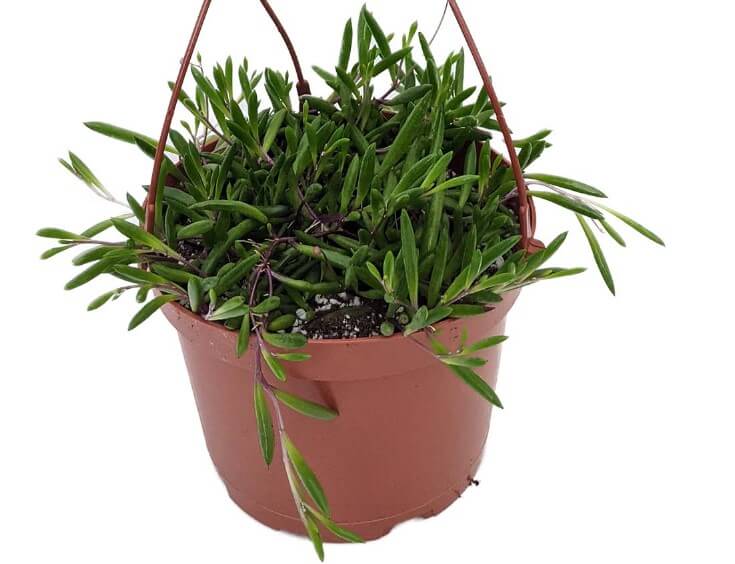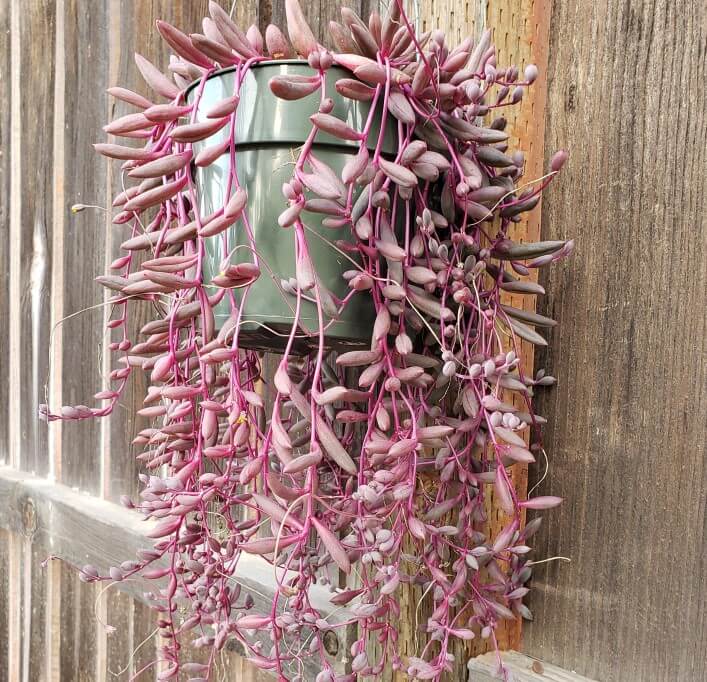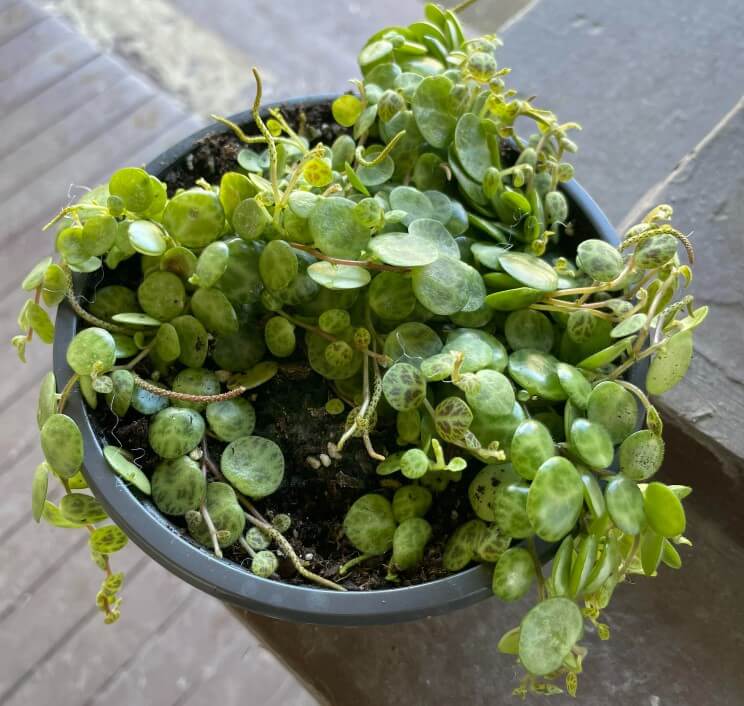How to Care And Propagation String Of Rubies Plant
(Othonna capensis), including pets and disease problem
Welcome, fellow plant enthusiasts! Today, we’re diving into the world of the stunning String of Rubies plant. This vibrant succulent is an excellent choice for indoor gardens thanks to its low-maintenance nature and eye-catching appearance.
We will explore essential care tips and how to overcome common issues like pesky diseases and pet safety. Buckle up, green thumbs – it’s time to amp up your horticulture knowledge on this ruby-red beauty! Read on for expert advice on keeping your String of Rubies thriving and propagating successfully.
Overview Of String Of Rubies Plant
| String Of Rubies Plant (Othonna capensis) (Crassothonna capensis) | |
|---|---|
| Scientific classification | |
| Kingdom: | Plantae |
| Clade: | Tracheophytes |
| Clade: | Angiosperms |
| Clade: | Eudicots |
| Clade: | Asterids |
| Order: | Asterales |
| Family: | Asteraceae |
| Genus: | Crassothonna |
| Species: | C. capensis |
| Binomial name | Crassothonna capensis (L.H.Bailey) B.Nord. |
| Synonyms | Othonna capensis L.H.Bailey Othonna crassifolia Harv., nom. illeg. Othonna filicaulis Eckl. ex Harv. |
(All information above are based on wikipedia.org)
The String of Rubies plant Othonna capensis is a stunning succulent that can turn red under stress. Its easy-to-grow nature and lack of toxicity make it a popular choice for households with children and pets.
However, like all plants, the String of Rubies requires proper care to thrive. In this blog post, we’ll discuss everything you need to know about caring for and propagating your String of Rubies plant, including tips on preventing disease problems in your beloved greenery. Keep reading to ensure your indoor space boasts healthy, flourishing, sizzling Ruby plants!

Characteristics And Appearance Othonna Capensis
The String of Rubies plant has remarkable features that any kid would love! These plants are like colorful, dangling gems, with their long trailing stems covered in small, round leaves. When they’re happily growing and getting just the right amount of sunlight, these funky leaves will be a beautiful shade of green. But guess what – sometimes, when they’re feeling a little stressed out from too much sun or not enough water (just like us on hot summer days), their color changes to a tremendous bright ruby red!
Not only do these plants have show-stopping colors, but they also have adorable flowers! That’s right; the String of Rubies can produce cute daisy-like yellow flowers at the end of its stems – how awesome is that? Just remember that it needs proper care and attention so it can grow indoors comfortably without any problems. So if you want to impress your friends with a unique houseplant or even start your indoor jungle, this plant is worth taking care of!
Native Habitat And Growing Conditions String Of Rubies
The String of Rubies plant is native to South Africa and can be found growing in rocky areas or along the slopes of mountains. In its natural habitat, this succulent grows in well-draining soil and receives plenty of sunlight. It’s also adapted to survive prolonged periods without water by storing moisture in its leaves.
When grown indoors, it’s essential to recreate these conditions as closely as possible for optimal growth. The String of Rubies plant requires a bright but indirect light source and should be placed near a window that gets plenty of sunlight throughout the day. Additionally, the soil should be well-draining to prevent root rot, which can occur if the roots sit in waterlogged soil for too long.
Finally, this plant thrives with moderate watering frequency – letting the top inch or two of soil dry out before watering again helps mimic its natural environment where rain may come infrequently. You will enjoy your beautiful ruby red plants year-round by mimicking these conditions at home!
String Of Rubies Plant Care
Proper care for your String of Rubies plant includes:
- Providing the right lighting and humidity.
- Watering and fertilizing as needed.
- Pruning regularly.
- Choosing the correct soil type.
- Being mindful of potential pests or diseases.
Keep reading to learn more about how to keep this stunning succulent thriving!
Proper Lighting And Humidity Requirements
The String of Rubies plant needs bright, indirect light to grow well. It can handle direct sunlight in the morning or late afternoon for a few hours, but avoiding it during peak hours is best.
Here are some tips on how you can provide proper lighting and humidity for your String of Rubies plant:
1. Place your plant near a window that receives bright but filtered light. Avoid placing it directly under the sun.
2. rotate the pot every few weeks to help all sides receive equal amounts of light.
3. Keep the temperature between 60 and 80 degrees Fahrenheit.
4. The String of Rubies likes a slightly humid environment, so you can mist its leaves with water every few days.
5. To increase humidity further, place a tray filled with pebbles and water underneath the plant pot (make sure the water doesn’t touch the bottom of the pot).
6. During winter or in dry climates, consider using a humidifier next to your plant to provide optimal growing conditions.
Remember that proper lighting and humidity are crucial elements for your String of Rubies plant’s growth and health!

Adequate Watering And Fertilizing Needs
String of Rubies plant requires proper watering and fertilizing to maintain optimal growth. Here are some tips:
1. Water your plant once every two weeks during the growing season and once a month during winter.
2. Ensure that the soil is completely dry between watering to avoid root rot
3. Water deeply enough to saturate the soil, but not too much as it can cause drainage problems.
4. Use a balanced fertilizer formulated for succulent plants in the growing season to promote healthy growth.
5. Apply fertilizer at half-strength every two weeks instead of full-strength once a month
6. Avoid using fertilizer during winter, as it can damage the plant’s roots.
7. Remember not to over-fertilize as it can lead to toxic build-up in the soil and harm the plant.
Keywords: String Of Rubies Plant Care And Propagation, succulent care, indoor plant care, watering frequency, drought tolerance, fertilization, cactus soil mix, plant nutrition
Pruning And Propagation Methods
Pruning and propagation are important techniques for keeping your String of Rubies plant healthy and growing. Here are some basic tips to get started:
1. Pruning:
– Use clean, sharp scissors or shears to cut back any dead or damaged parts of the plant.
– Pinch off growth tips to encourage branching and a fuller shape.
– Rotate the plant every few weeks to ensure even growth.
2. Propagation:
– Stem cutting: choose a stem with at least 2-3 nodes and cut at an angle just below a node.
– Place in soil or water until roots develop, then transplant into its own pot.
– Division: carefully separate clumps of stems at the root level and plant each in its own pot.
– Seeds: sow seeds in well-draining soil and keep moist until germination occurs.
Remember to carefully handle your String of Rubies plant when pruning or propagating, as its stems can be fragile. By using these techniques, you can help your plant thrive and propagate new ones to share with friends!
Soil Type And Nutrition
The String of Rubies plant grows best in well-draining soil, just like other succulents. This type of soil allows air to flow through it freely, thus preventing root rot from developing. The ideal soil mix for this plant should contain sandy or gritty materials such as perlite, gravel, and coarse sand to enhance drainage. Adding peat moss or coconut coir increases the moisture retention capacity of the soil but is not recommended since these types retain moisture more than necessary.
When planting a string of rubies, be sure to choose a container with drainage holes at the bottom that will prevent waterlogged conditions. Remember not to overwater your plant; water only when the top inch of soil feels dry to the touch.
While fertilization is not usually required for String Of Rubies plants, a light application every month during active growth can promote healthy growth and better flowering. Experts recommend using a balanced fertilizer containing nitrogen (N), phosphorus (P), potassium (K), and trace minerals about once every three months OR adding slow-release granules into your potting mix can reduce frequent applications while still providing adequate nutrients for it to thrive properly.
Common String Of Rubies Plant Problems
The String of Rubies plant is susceptible to root rot, which can be caused by overwatering and poor soil drainage; common pests such as fungus gnats, spider mites, and mealybugs can also infest the plant, leading to stunted growth and wilting leaves. Leaf drop and shriveling are other issues that may arise due to cultural faults or inadequate lighting.
Root Rot: Causes And Prevention
Root rot is a common problem that can affect the health and growth of your String of Rubies plant. This condition happens when the roots become infected with fungus, which causes them to decay and turn brown in color. Overwatering your plant is one of the main causes of root rot since it creates an environment sopping wet for fungi to grow.
To prevent root rot, you need to ensure that your soil is well-draining so excess water can quickly drain away from the roots after watering. In addition, avoid leaving standing water in saucers or trays beneath pots. You should also make sure not to overwater and only give enough moisture when needed, as succulents thrive in a more drought-tolerant environment.
If you notice any signs of root rot like droopy leaves or discolored roots, act promptly by reducing watering frequency until its soil dries out thoroughly before wetting again, as being proactive will help save your String Of Rubies Plant’s life!

Pest Management: Fungus Gnats, Spider Mites, And Mealybugs
The String of Rubies plant can face several pests that can harm its growth. Here’s a list of bugs to watch out for and how to manage them:
1. Fungus Gnats: These are small flies that infest the soil and feed on the roots, causing root rot. To prevent them, avoid overwatering your plant and allow the soil to dry out between watering.
2. Spider Mites: These tiny insects suck the sap from leaves, causing yellowing and webbing. To get rid of them, spray the plant with water or insecticidal soap.
3. Mealybugs: These white, fluffy insects feed on plant sap and leave a sticky residue on leaves. Remove them with a cotton swab soaked in alcohol or insecticidal soap.
Remember always to check your plants for pests regularly and take action right away to avoid any damage to your String of Rubies Plant!
Leaf Drop And Shrivel: Causes And Solutions
Sometimes, the leaves of your String of Rubies can start to droop or shrivel up. A few different things can cause this. One cause could be overwatering – if you’re watering too often, the plant’s roots may become waterlogged and unable to absorb oxygen, leading to leaf drop. Another cause could be underwatering – if the plant is not getting enough water, it may conserve its resources by dropping some of its leaves.
The easiest way to solve both these problems is by adjusting your watering schedule appropriately based on how dry the soil feels when you stick your finger in it (about an inch deep). You should also ensure the pot has adequate drainage holes so that excess water doesn’t get trapped at the bottom, leading to root rot.
If neither issue seems to be causing the leaf drop, check for pests like spider mites or mealybugs, which can suck sap from plants and weaken them with damaged leaves prone to falling off. Get rid of any affected parts immediately and apply pest control measures using natural insecticides made from household items such as dish soap mixed with warm water or rubbing alcohol mixed in equal proportions with clean spray bottles, following guidelines carefully so as not to harm plant health nor damage environment around home/property/garden areas where they are planted.
String Of Rubies Plant Safety And Propagation
To propagate the String of Rubies plant, stem cuttings with at least two to three nodes can be used for propagation in soil or water, while division and seed propagation are possible methods as well; however, it’s important to exercise caution when handling the fragile stems during propagation while also keeping in mind that this plant is toxic to pets and children.
Propagation Methods: Stem Cutting, Leaf Cutting, And Division
Propagating the String of Rubies plant can be fun and rewarding. Here are three easy methods to try:
1. Stem Cutting: Take a stem cutting that has at least two to three nodes (where the leaves emerge). Remove the bottom leaves, leaving a small stub. Allow the cuttings to dry for a day or two, then insert them into well-draining soil or water. Keep the soil or water moist until roots form.
2. Leaf Cutting: Select a healthy leaf and gently remove it from the stem, including part of the petiole (the stalk that joins the leaf to the stem). Let it dry for a day or two, then insert it into well-draining soil or water. Keep moist until new growth emerges.
3. Division: If your plant has grown large enough, you can divide it into smaller plants by carefully separating the stems at their base. Each new plant should have several stems and some roots attached.
Remember to handle plant cuttings with care, as they can be fragile. With these propagation methods, you can share your love for String of Rubies plants with friends and family!
Safety Precautions: Toxicity For Pets And Children, Safe Placement And Handling
It’s important to keep your pets and children safe when handling the String of Rubies plant. While this plant is considered non-toxic, it can cause mild stomach upset if ingested in large quantities. To avoid any issues, make sure to keep the plant out of reach from small children and pets who may be tempted to play with or eat the leaves.
When handling the String of Rubies plant, be gentle with its delicate stems and leaves. Avoid pulling on them or bending them too far, as they may snap off easily. Using sharp scissors or shears to make a clean cut close to where the stem meets the main plant if taking stem cuttings for propagation. You can enjoy this beautiful succulent without worry with proper care and attention!
Conclusion: The Importance Of String Of Rubies Care And Propagation
In conclusion, taking care of your String of Rubies plants is essential to ensure they thrive in their indoor environment. From making sure they have the right amount of sunlight and water to keeping them away from harmful toxins that can harm pets and children, proper care is key to their healthy growth. And if you want to expand your collection or share this beautiful plant with a friend, propagation techniques like stem cuttings and division make it easy! With just a little effort and some love for your string of Rubies plants, you’ll enjoy watching them flourish while adding a touch of natural beauty to your home.